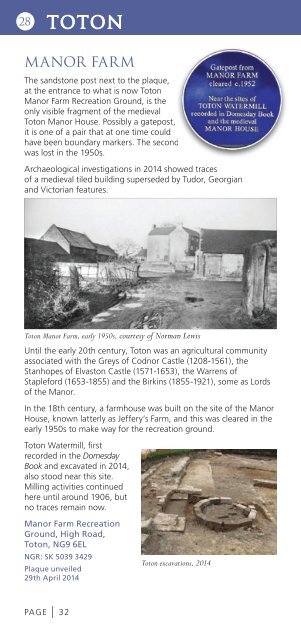GUIDE TO THE BLUE PLAQUES
BP%20final%20proof.2016.05.03
BP%20final%20proof.2016.05.03
You also want an ePaper? Increase the reach of your titles
YUMPU automatically turns print PDFs into web optimized ePapers that Google loves.
28 <strong>TO</strong><strong>TO</strong>N<br />
STAPLEFORD<br />
29<br />
MANOR FARM<br />
The sandstone post next to the plaque,<br />
at the entrance to what is now Toton<br />
Manor Farm Recreation Ground, is the<br />
only visible fragment of the medieval<br />
Toton Manor House. Possibly a gatepost,<br />
it is one of a pair that at one time could<br />
have been boundary markers. The second<br />
was lost in the 1950s.<br />
Archaeological investigations in 2014 showed traces<br />
of a medieval tiled building superseded by Tudor, Georgian<br />
and Victorian features.<br />
ADMIRAL SIR JOHN BORLASE<br />
WARREN, BART, GCB<br />
1753-1822<br />
He was a great naval officer who<br />
served his country well, a popular<br />
local hero. ‘Warren for ever!’ cried<br />
local crowds at the news of Sir John’s<br />
triumphs at sea.<br />
John Borlase Warren was born and lived<br />
at Stapleford Hall, a stone’s throw from<br />
the plaque. He enjoyed a distinguished naval<br />
career, rising from able seaman in 1771 to Admiral in 1810.<br />
Many successes in the Channel and off the French coast led to him<br />
being honoured in 1794 as a Knight Companion of the Order of the<br />
Bath (KB) and being granted the freedom of Nottingham. In 1796<br />
his squadron captured or destroyed some 220 French vessels. In<br />
1798 the thwarting of a French fleet from aiding an Irish rebellion<br />
against Britain earned him the thanks of Parliament and the<br />
freedom of London and Londonderry.<br />
Toton Manor Farm, early 1950s, courtesy of Norman Lewis<br />
Until the early 20th century, Toton was an agricultural community<br />
associated with the Greys of Codnor Castle (1208-1561), the<br />
Stanhopes of Elvaston Castle (1571-1653), the Warrens of<br />
Stapleford (1653-1855) and the Birkins (1855-1921), some as Lords<br />
of the Manor.<br />
In the 18th century, a farmhouse was built on the site of the Manor<br />
House, known latterly as Jeffery’s Farm, and this was cleared in the<br />
early 1950s to make way for the recreation ground.<br />
Toton Watermill, first<br />
recorded in the Domesday<br />
Book and excavated in 2014,<br />
also stood near this site.<br />
Milling activities continued<br />
here until around 1906, but<br />
no traces remain now.<br />
Manor Farm Recreation<br />
Ground, High Road,<br />
Toton, NG9 6EL<br />
NGR: SK 5039 3429<br />
Plaque unveiled<br />
29th April 2014<br />
PAGE | 32<br />
Toton excavations, 2014<br />
As a politician, he was MP for Great Marlow, for<br />
Nottingham and then for Buckingham. He was<br />
sworn in as a Privy Councillor in 1802 and<br />
appointed Ambassador to the Russian Court<br />
at St Petersburg from 1802-1804.<br />
He returned to sea as Commander-in-<br />
Chief of the fleet off North America<br />
from 1807-1810 and again in 1813-1814,<br />
first fighting the French and then the<br />
Americans. In 1815 he was elevated to<br />
the Knight Grand Cross of the Order of<br />
the Bath (GCB).<br />
Walter Parker VC Memorial Square,<br />
near 71 Derby Road, Stapleford, NG9 7AR<br />
NGR: SK 4869 3701<br />
Plaque unveiled 18th May 2011<br />
Stapleford Hall<br />
Admiral Sir John Borlase<br />
Warren, Bart, GCB<br />
PAGE | 33


